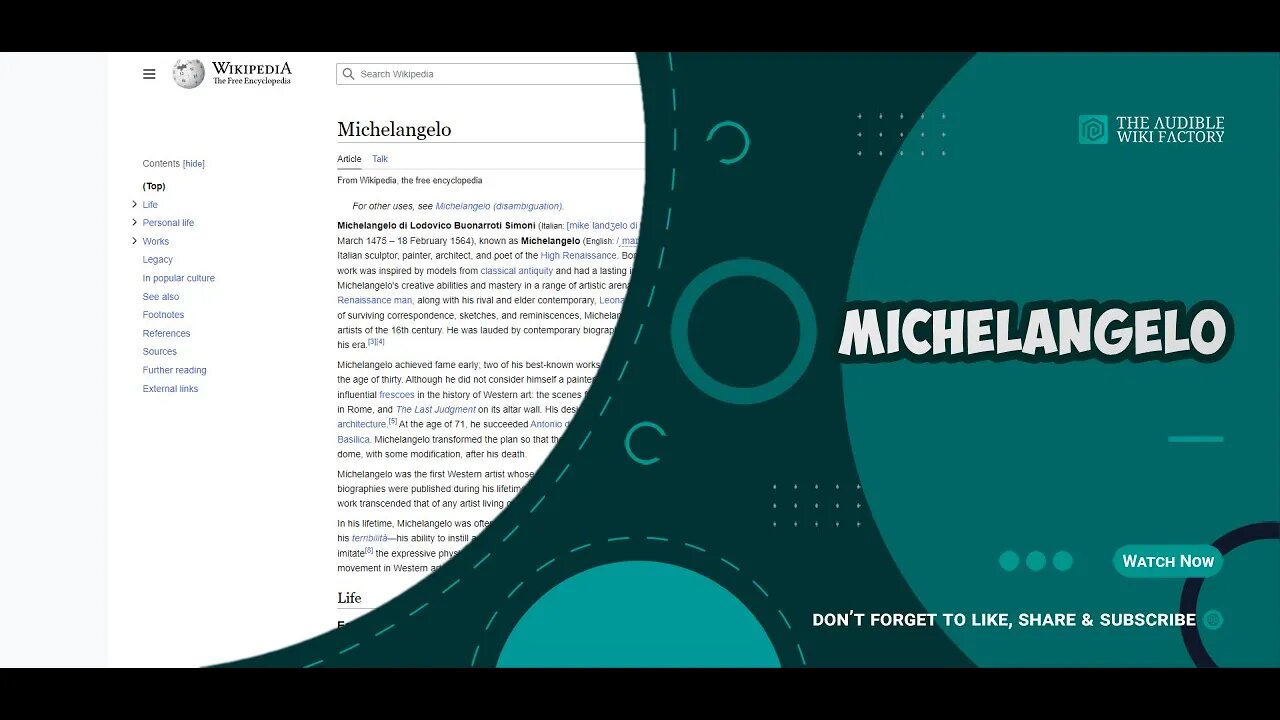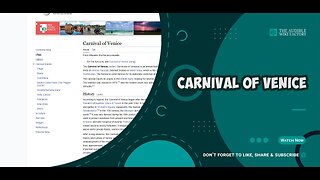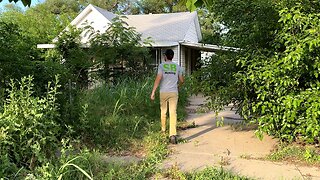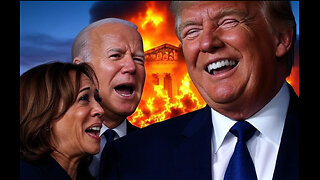Premium Only Content

Michelangelo di Lodovico Buonarroti Simoni, known as Michelangelo, was an Italian sculptor,
Michelangelo di Lodovico Buonarroti Simoni, known as Michelangelo, was an Italian sculptor, painter, architect, and poet of the High Renaissance. Born in the Republic of Florence, his work was inspired by models from classical antiquity and had a lasting influence on Western art. Michelangelo's creative abilities and mastery in a range of artistic arenas define him as an archetypal Renaissance man, along with his rival and elder contemporary, Leonardo da Vinci. Given the sheer volume of surviving correspondence, sketches, and reminiscences, Michelangelo is one of the best-documented artists of the 16th century. He was lauded by contemporary biographers as the most accomplished artist of his era.
Michelangelo achieved fame early; two of his best-known works, the Pietà and David, were sculpted before the age of thirty. Although he did not consider himself a painter, Michelangelo created two of the most influential frescoes in the history of Western art: the scenes from Genesis on the ceiling of the Sistine Chapel in Rome, and The Last Judgment on its altar wall. His design of the Laurentian Library pioneered Mannerist architecture. At the age of 71, he succeeded Antonio da Sangallo the Younger as the architect of St. Peter's Basilica. Michelangelo transformed the plan so that the western end was finished to his design, as was the dome, with some modification, after his death.
Michelangelo was the first Western artist whose biography was published while he was alive. In fact, two biographies were published during his lifetime. One of them, by Giorgio Vasari, proposed that Michelangelo's work transcended that of any artist living or dead, and was "supreme in not one art alone but in all three."
In his lifetime, Michelangelo was often called Il Divino ('the divine one'). His contemporaries often admired his terribilità—his ability to instill a sense of awe in viewers of his art. Attempts by subsequent artists to imitate the expressive physicality of Michelangelo's style contributed to the rise of Mannerism, a short-lived movement in Western art following the High Renaissance.
EARLY LIFE, 1475–1488
Michelangelo was born on 6 March 1475 in Caprese, known today as Caprese Michelangelo, a small town situated in Valtiberina, near Arezzo, Tuscany. For several generations, his family had been small-scale bankers in Florence; but the bank failed, and his father, Ludovico di Leonardo Buonarroti Simoni, briefly took a government post in Caprese, where Michelangelo was born. At the time of Michelangelo's birth, his father was the town's judicial administrator and podestà or local administrator of Chiusi della Verna. Michelangelo's mother was Francesca di Neri del Miniato di Siena. The Buonarrotis claimed to descend from the Countess Mathilde of Canossa—a claim that remains unproven, but which Michelangelo believed.
Several months after Michelangelo's birth, the family returned to Florence, where he was raised. During his mother's later prolonged illness, and after her death in 1481 (when he was six years old), Michelangelo lived with a nanny and her husband, a stonecutter, in the town of Settignano, where his father owned a marble quarry and a small farm. There he gained his love for marble. As Giorgio Vasari quotes him:
If there is some good in me, it is because I was born in the subtle atmosphere of your country of Arezzo. Along with the milk of my nurse I received the knack of handling chisel and hammer, with which I make my figures.
LINK TO ARTICLE: http://en.wikipedia.org/wiki/Michelangelo
TAGS: Michelangelo, Sculptors from Tuscany, Renaissance sculptors, Renaissance painters, Renaissance artists, People from the Province of Arezzo, People celebrated in the Lutheran liturgical calendar, Painters from Tuscany, LGBT artists from Italy, Italian Roman Catholics, Italian ecclesiastical architects, Italian Renaissance sculptors, Italian Renaissance painters, Italian Renaissance architects, Italian male sculptors, Catholic sculptors, Catholic painters, Burials at Basilica of Santa Croce Florence, Artist authors, Architects of Roman Catholic churches, 16th-century LGBT people, 16th-century Italian sculptors, 15th-century Italian sculptors, 16th-century Italian painters, Italian male painters, 15th-century Italian painters, 16th-century Italian architects, 16th-century people of the Republic of Florence, 15th-century people of the Republic of Florence, Michelangelo
#GeneralKnowledge #AudibleWikiFactory #Audible #Wikipedia #Michelangelo
-
 13:12
13:12
The Audible Wiki Factory
1 year agoThe Carnival of Venice is an annual festival held in Venice, Italy. The carnival ends on Shrove
498 -
 44:13
44:13
barstoolsports
14 hours agoThe Shred Line with Coach Gruden, Dave Portnoy and Steven Cheah | Week 17
91.5K8 -
 2:24:54
2:24:54
WeAreChange
10 hours agoTrump Sides With Musk On Visas! MAGA Base ENRAGED??
83.4K83 -
 2:04:26
2:04:26
Nerdrotic
11 hours ago $23.88 earnedThe Program: The Government's UFO Cover Up Programs | Forbidden Frontier #085
63.9K16 -
 2:13:07
2:13:07
vivafrei
13 hours agoEp. 243: HOLIDAY SPECIAL! The Great H1B Visa Debate! Jay z Gets Scorched! Attack in Germany! & MORE!
141K316 -
 16:40
16:40
Russell Brand
15 hours agoTHIS MASSIVELY BACKFIRED...
172K607 -
 25:41
25:41
SB Mowing
19 hours agoPICTURE living next to THIS and not knowing what to do…
124K73 -
 2:16:01
2:16:01
George Galloway
1 day agoNEW YEAR COUNTDOWN - MOATS with George Galloway - EP 408
128K240 -
 18:39
18:39
Stephen Gardner
15 hours ago🔥BREAKING! Trump's SHOCKING New Demand | Biden admits DOJ TARGETED Trump Illegally!
99.6K428 -
 1:20:23
1:20:23
Josh Pate's College Football Show
20 hours ago $15.35 earnedCFP Prediction Special: OhioSt vs Oregon | UGA vs Notre Dame | Texas vs ASU | Boise vs PennSt
124K6